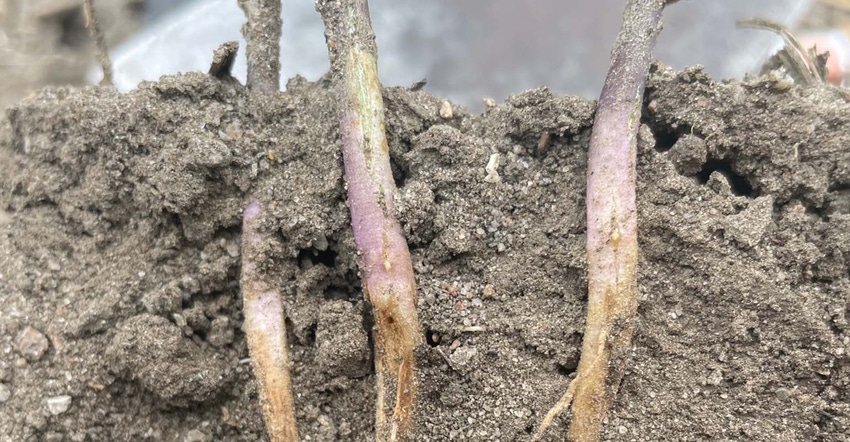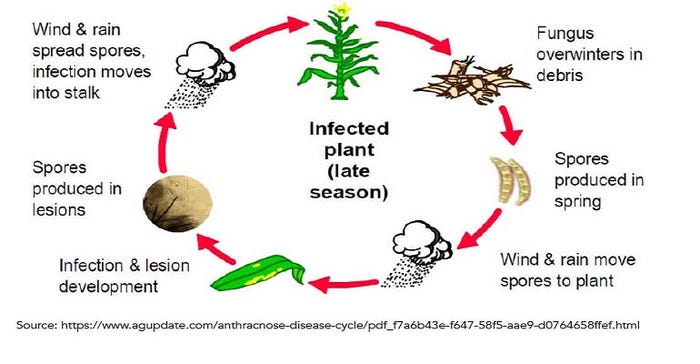October 1, 2022

Sponsored Content
At this time of year, we get a lot of questions from farmers regarding the prevention of diseases in our crops for the next growing season. Specifically, “Is there anything I can do now?”
The growing season has concluded and regardless of the weather conditions in your respective area, the harvest we will manage is the result of what we cannot control (rainfall, sunshine, and temperature) and what we can control. Focusing on what we can control (before tillage equipment is cleaned and stored and harvest results become our focus), we can determine what things could have been controlled that we need or want to address before planting next year. It’s also important to consider what pests (insects, diseases, or weeds) impacted your net yield production. For some, the presence and activity of root rots and stem diseases was an impact that falls in the grey zone of a can and a cannot. When I look at this past spring, the following pathogens were observed or reported:
CORN
• Fusarium Root Rot
• Anthracnose Leaf Blight
SOYBEANS
• Fusarium Root Rot
• Rhizoctonia Root Rot
• Sudden Death Syndrome
• Phytophthora Root Rot
• Bacterial Blight
These pathogens are present in most, if not all, of our soils. Where they are at elevated levels, and the plant is prime for infection, the influence on growth will be defined. Although each pathogen has preferred environmental conditions (cold and wet, wet then dry, wet and cool followed by hot, etc.), our goal is to keep the pathogen levels low so that when optimum conditions for a disease arise, the impact of the disease will stay in a range we can control. When looking at the entire production system, our first action to manage (control) diseases is Integrated Pest Management (IPM). IPM is an approach to managing pests that combines biological, cultural, physical (mechanical), and chemical actions/ practices/tools.
Before addressing a disease issue, we must correctly identify the pathogen, understand its life cycle, and recognize what soil environmental conditions and characteristics enabled the disease to influence crop growth and subsequent yield. Was it only in certain soil types, tillage practices/timing, planting dates, or cultivars? The correlation between Fusarium Root Rot and Corn Rootworm feeding is very strong. Was it untethered larvae feeding that created injured or stressed roots and the opportunity for infection? Under suitable conditions, the root rot can lead to Crown Rot or Stalk Rot. With IPM in mind, these are some of the many tools to consider when a disease level affects production.
Cultural: Plant resistance and/or tolerance; crop rotation; planting date and quality; balanced nutrient availability; tillage type, timing, and effectiveness; and residue management
Biological: Beneficials in seed treatments; application of at-plant or post-planting carbohydrates; and balanced soil health for air and water
Physical: Removal of diseased plants; row cultivation/soil movement; drainage; irrigation; and unintended introduction of the pathogen
Chemical: Effective and properly applied fungicide and insecticide seed treatments; at-plant applications; and foliar applications
What are actions you can employ now before you plant in 2023? The cultural aspect of IPM is top of the “can” list. Cultivar selection and crop rotation are first and foremost. Where Phytophthora Root Rot is present and impactful, choose soybean varieties that provide a diverse PRR resistance and/or tolerance to the races you have and widen the rotation of soybeans. If Sudden Death Syndrome (SDS) limits yields, choose soybean varieties with higher SDS tolerance. Also look to control Soybean Cyst Nematode (SCN) presence and minimize soil compaction. Looking at the production system, these are key actions to work toward our goal of reducing pathogen levels.
SOIL FERTILITY/NUTRIENT MANAGEMENT:
In most cases, a healthy plant is more defensive. Each respective pathogen has its own preferential gaps. Potassium (K) availability and uptake are critical for its role in cellular strength and plant defenses for many soil-borne pathogens.

SOIL QUALITY:
Soil quality is affected by the integration of beneficial soil physical, chemical, and biological properties and processes. Many of our most damaging pathogens thrive in anaerobic (low to no oxygen) conditions that are detrimental to many beneficial bacteria and fungi.
RESIDUE MANAGEMENT:
This is not a fix-all by any means. As shown in the Disease Cycle above, burying the residue of an infected crop can help, but if soil fertility (pH, OM, EC, and nutrients) or the soil quality is poor, the benefit may be nominal. If Sclerotinia Stem Rot (White Mold or SWM) is found, burying the over-wintering sclerotia (black, fungal bodies) can be a zero-sum factor if in a rotation with soybeans (or other SWM susceptible crops) and other IPM measures are not enacted.
UNINTENDED CONSEQUENCES:
Several other factors can play a part in disease prevention and IPM. These include, but are not limited to, infected soils and residue, movement by animals, equipment, and weather, planting alternate host cover crops for diseases and insects, and avoiding the management of other pests like weeds, volunteer corn, and insects. An overriding factor for some growers is balancing short-term vs. longterm economics. If you’re in the second or third year of a soybean-after-soybean rotation, this year may be profitable, but what will be the cost to control SWM four, five, or ten years down the road?
Preventing or managing diseases is an ongoing process. Incorporating the guiding principles of IPM to be sustainable, economical, environmentally sound, and applicable to your operation is fundamental. Don’t hesitate to contact me or another Beck’s representative with any questions or thoughts. Together we can work to find a potential solution to assist you in controlling diseases on your farm.
Additional pest management information: BecksHybrids.com/Agronomy/Agronomy-Resources, CropProtectionNetwork.org/, your respective state Extension Service, and the management resources at BecksHybrids.com/PFR/About-PFR
Beck's - Farmers At Heart® - revolutionized the customer seed buying experience by remaining true to a foundation built on faith, family, and farming. Founded in 1937, Beck's appreciates the farmers who have helped them become the largest family-owned retail seed company and the third largest seed brand in the United States. The Beck family is now in its fifth generation of family members who work in the business to honor God and help farmers succeed. The Beck family and team of employees help farmers achieve success from generation to generation through authentic customer experiences, product diversity, seed quality, and performance. With a home office located in Atlanta, Ind., Beck's serves farmers throughout the Midwest and Mid-South. For more information about Beck's Superior Hybrids, Inc., visit www.beckshybrids.com.
About the Author(s)
You May Also Like




